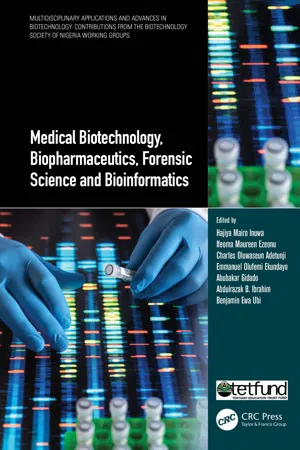
Medical Biotechnology, Biopharmaceutics, Forensic Science and Bioinformatics
Hajiya Mairo Inuwa, Ifeoma Maureen Ezeonu, Charles Oluwaseun Adetunji, Emmanuel Olufemi Ekundayo, Abubakar Gidado, Abdulrazak B. Ibrahim, Benjamin Ewa Ubi, Hajiya Mairo Inuwa, Ifeoma Maureen Ezeonu, Charles Oluwaseun Adetunji, Emmanuel Olufemi Ekundayo, Abubakar Gidado, Abdulrazak B. Ibrahim, Benjamin Ewa Ubi
- 430 pagine
- English
- ePUB (disponibile sull'app)
- Disponibile su iOS e Android
Medical Biotechnology, Biopharmaceutics, Forensic Science and Bioinformatics
Hajiya Mairo Inuwa, Ifeoma Maureen Ezeonu, Charles Oluwaseun Adetunji, Emmanuel Olufemi Ekundayo, Abubakar Gidado, Abdulrazak B. Ibrahim, Benjamin Ewa Ubi, Hajiya Mairo Inuwa, Ifeoma Maureen Ezeonu, Charles Oluwaseun Adetunji, Emmanuel Olufemi Ekundayo, Abubakar Gidado, Abdulrazak B. Ibrahim, Benjamin Ewa Ubi
Informazioni sul libro
This book covers a range of topics on exploiting Nigeria's mega biodiversity for food security and health; DNA forensic science and its applications; medical biotechnology and biopharmaceutics; medicinal and underutilized plants; impact and mitigation of antibiotic resistance; bioinformatics applications; medical insect biotechnology; etc. The book will be useful reference material for the scientists and researchers working in the fields of nutraceuticals, molecular diagnostics and DNA forensics, biopharmaceuticals and medical biotechnology, nanotechnology, antimicrobials from indigenous plant species, bioinformatics, etc.
-
- Emphasizes recent advances in biotechnologies that will help in tackling emerging global health challenges
-
- Provides detailed information on how to harness indigenous bioresources including microorganisms and plants for healthcare delivery
-
- Introduces new frontiers in the areas of molecular diagnostics and DNA forensic science and bioinformatics with case studies, recent advances in medical insect biotechnology and molecular genetics of pest use towards the exploitation of arthropod midgut components to develop interventions against infectious diseases
-
- Reviews bioactive molecules derived from commonly used and underutilized medicinal plants that could be used to develop novel drugs for improved healthcare delivery
-
- Discusses current approaches in medical and biopharmaceutical biotechnology, deployment of inexpensive genomics-based vector surveillance for effective disease outbreak prediction and control of mosquito-borne viruses
Hajiya Mairo Inuwa, Ph.D., is Professor in the Department of Biochemistry and Formerly Director, Centre for Biotechnology Research and Training (CBR&T), Ahmadu Bello University, Zaria, Nigeria.
Ifeoma Maureen Ezeonu, Ph.D., is Professor of Medical Microbiology and Molecular Genetics in the Department of Microbiology, University of Nigeria, Nsukka, Nigeria.
Charles Oluwaseun Adetunji, Ph.D., is Associate Professor of Microbiology and Biotechnology and Director of Intellectual Property and Technology Transfer, Edo State University, Uzairue, Nigeria.
Abubakar Gidado, Ph.D., is Professor of Biochemistry and Director of North-East Zonal Biotechnology Centre of Excellence at the University of Maiduguri.
Emmanuel Olufemi Ekundayo, Ph.D., is Associate Professor of Medical Microbiology and Microbial Genetics, Michael Okpara University of Agriculture, Umudike, Nigeria.
Abdulrazak B. Ibrahim, Ph.D., is a Capacity Development Expert at the Forum for Agricultural Research in Africa (FARA) and Associate Professor of Biochemistry, Ahmadu Bello University, Zaria, Nigeria.
Benjamin Ewa Ubi, Ph.D., is a Professor of Plant Breeding and Biotechnology and Director, Biotechnology Research and Development Centre, Ebonyi State University, Abakaliki, Nigeria.
Domande frequenti
Informazioni
Part 1 Working Group 04 Molecular Diagnostics and DNA Forensics
1 Principles and Techniques for Deoxyribonucleic Acid (DNA) Manipulation
Contents
- 1.1 Introduction
- 1.2 Molecular Structure of the Nucleic Acids
- 1.2.1 Chemical Nature of the Nucleic Acids
- 1.2.2 The DNA Double Helix
- 1.2.3 DNA Renatures as well as Denatures
- 1.2.4 Functions of DNA and RNA
- 1.3 DNA Replication and Gene Expression in Prokaryotes and Eukaryotes
- 1.3.1 DNA Replication
- 1.3.2 Stages of DNA Replication
- 1.3.2.1 Initiation
- 1.3.2.2 Elongation
- 1.3.2.3 Termination
- 1.3.3 Gene Expression
- 1.3.3.1 Transcription
- 1.3.3.2 Translation (Protein Synthesis)
- 1.3.4 Regulation of Gene Expression
- 1.3.4.1 Regulation of Gene Expression in Eukaryotes
- 1.3.4.2 Regulation of Gene Expression in Prokaryotes
- 1.4 Laboratory Techniques for DNA Extraction from Various Cell Types
- 1.4.1 DNA Isolation, Purification and Quantification
- 1.4.1.1 DNA Extraction Steps
- 1.4.1.2 Measuring DNA Concentration and Purity
- 1.4.2 Agarose Gel Electrophoresis and Polyacrylamide Gel Electrophoresis (PAGE)
- 1.4.2.1 Polyacrylamide Gel Electrophoresis Principle
- 1.4.3 Other DNA-Based Molecular Techniques
- 1.4.3.1 Denatured Gradient Gel Electrophoresis
- 1.4.3.2 Recombinant DNA Technologies
- 1.4.3.3 Polymerase Chain Reaction – Types and Applications
- 1.4.3.4 Restriction Fragment Length Polymorphism (RFLP) and Ribotyping
- 1.4.3.5 Sequencing – Sanger and Next Gen Applications
- 1.4.1 DNA Isolation, Purification and Quantification
- 1.5 Conclusion and Recommendations
- References
1.1 Introduction
1.2 Molecular Structure of the Nucleic acids
1.2.1 Chemical Nature of the Nucleic Acids







